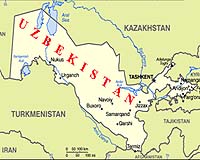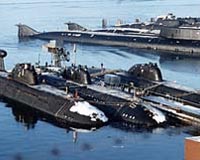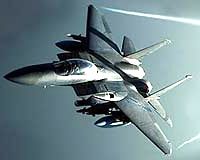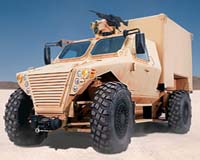
Analysis: Uzbek uranium exports in increase
Jul 14, 2008: Record-high oil prices are causing many nations to re-evaluate other energy options, especially nuclear power, despite its environmental shortcomings. As the number of nuclear plants increases, so will demand for uranium, giving producer nations increased market opportunities.
Since 2001 uranium prices have increased more than 1,000 percent; seven years ago a pound of uranium sold for $5 to $10; current spot prices are $59 a pound, but they peaked last year at more than $130 a pound.
Last year the International Atomic Energy Agency reported there were 439 nuclear power reactors worldwide in 31 countries generating 372,000 megawatts, with 34 reactors under construction worldwide. For the future the IAEA has revised its estimates of new construction of nuclear power stations worldwide to at least 60 new facilities in the next 15 years.
The nuclear issue has even impacted the U.S. presidential race, with presumptive Republican nominee John McCain committing his administration, if he is elected, to begin planning for the eventual construction of 45 new nuclear power plants in the United States by 2030.
Europe is similarly interested in expanding its nuclear power industry, which represents 45 percent of the world's currently operating nuclear facilities and 33 percent of new reactor construction. European nations currently operate 197 nuclear power plants generating 169,842 megawatts, and 12 European countries are planning or considering proposals for up to 67 additional reactors.
The revival of interest in nuclear power will prove a boon for uranium-producing nations. Canada currently leads global production, with 25 percent of the world's output. Other important uranium mining nations include the United States, Australia, Portugal, Namibia and Niger.
It is in the former Soviet Union, however, where several nations are currently experiencing an oil boom, that much of the world's future production will be extracted. Russia and Kazakhstan, already major oil producers, have significant uranium reserves. Kazakhstan is currently the world's third-biggest uranium miner, exceeded only by Australia and Canada; the three countries currently account for more than half of global uranium production.
Another former Soviet republic left out of the hydrocarbon rush, Uzbekistan, is poised to enter the world market.
According to the IAEA, Uzbekistan has the world's seventh-largest uranium reserves and is the fifth-largest producer. Uzbekistan's State Committee on Geology and Mineral Resources states the country's confirmed and estimated uranium reserves total 185,800 tons scattered across 40 fields.
Current world production of uranium is 39,603 tons; according to the Uzbek government, by reopening old uranium mines and beginning work at new uranium deposits, Tashkent intends to increase uranium production to nearly 3,500 tons annually from its 2007 level of 2,270 tons. As Uzbekistan does not currently have its own atomic industry, all of its production of low-enriched uranium is exported, except for that used in two research reactors in Tashkent and Samarkand.
All Uzbek uranium production, enrichment and export is conducted by the Navoiiskii Gorno-Metallurgicheskii Kombinat (Navoi Mining-Metallurgical Complex, or NGMK) monopoly, based in Navoi province, now one of the world's Top 10 producers of uranium and gold.
According to NGMK Director General Kuvandik Sanakulov, last year the facility began implementing a five-year modernization program that includes equipment renovation as well as opening additional processing plants and mines. Sanakulov said NGMK had received $165 million in additional funding. He said: "We are planning to start operations in several new uranium deposits. We also will increase production of uranium oxide (from older fields) by underground leaching of uranium ore deposits." Among the new sites to be developed is the Northern Kanimekh field. NGMK is not going it completely alone: Germany's Nukem GmbH issued NGMK a $14 million loan for upgrading technological equipment.
As for who will be interested in Uzbekistan's uranium production, the usual suspects are China, Russia and the United States.
China's voracious economic growth has led its government to prospect for indigenous uranium deposits in order to produce 40 gigawatts of nuclear power electrical generating capacity by 2020. China is also developing a national uranium reserve, but neither goal will be achieved with local sources, as analysts predict by 2017 China's nuclear power plants will consume 44 million pounds of uranium annually, as more than 16 provinces, regions and municipalities have announced intentions to build nuclear power plants by 2015, a total of 77 planned and proposed new reactors.
Russia is similarly stymied. While Russian state holding company Atomprom is the world's seventh-largest holder of uranium ore reserves, the third-largest producer of nuclear fuel and the world's fifth-largest miner of uranium, current Russian production is only 3,000 metric tons of uranium ore out of an annual requirement of 18,000 metric tons. Currently Russia's sole uranium deposit is its Streltsovsky mining and chemical plant in Chita.
As for the United States, a precipitous rush to judgment by the Bush administration in the aftermath of the May 2005 Andijan tragedy, in which nearly 200 people died, produced a chill in relations between Tashkent and Washington that only recently has begun to thaw.
So who is the preliminary winner? South Korea. Earlier this year South Korean Prime Minister Han Seung-soo visited Tashkent as part of his "energy diplomacy" tour of Central Asia. On May 11 Han signed a $400 million agreement with the Uzbek government for the right to import 2,600 tons of uranium between 2010 and 2016. The amount represents about 9 percent of South Korea's annual uranium consumption of 4,000 tons.
As the triangular struggle between the West, Russia and China for Central Asia's mineralogical wealth continues, the South Korean-Uzbek uranium deal should serve as a paradigm of Central Asia's determination to sign mutually beneficial agreements rather than exploitative buccaneering capitalist agreements, whereby producers are forced to sell their materials at rock-bottom prices. As Seoul and Tashkent have shown, modest, equitable agreements are preferable to larger, extortionate ones. As Central Asia consolidates its economic and political gains since the 1991 collapse of communism, Washington, Moscow and Beijing should listen, especially if they wish to slake their ever increasing thirst for energy.





























